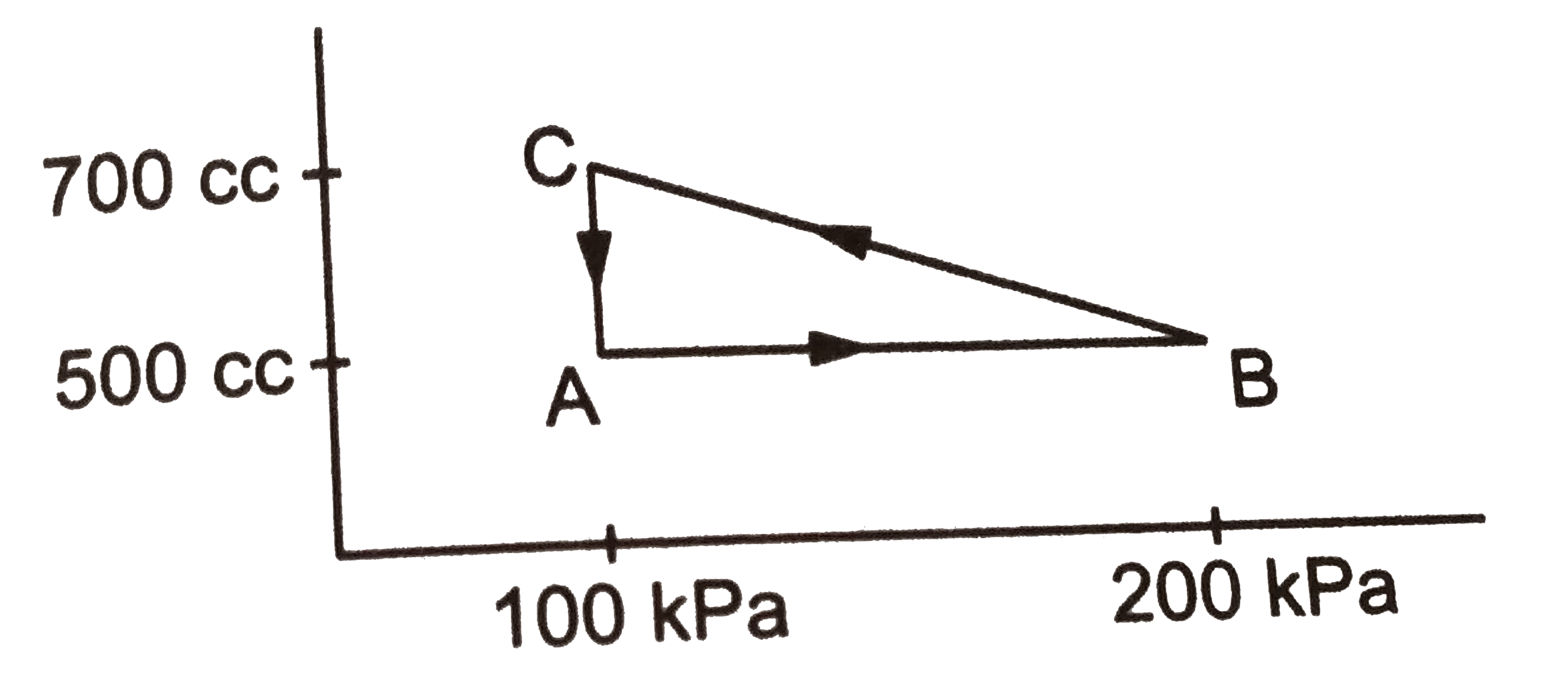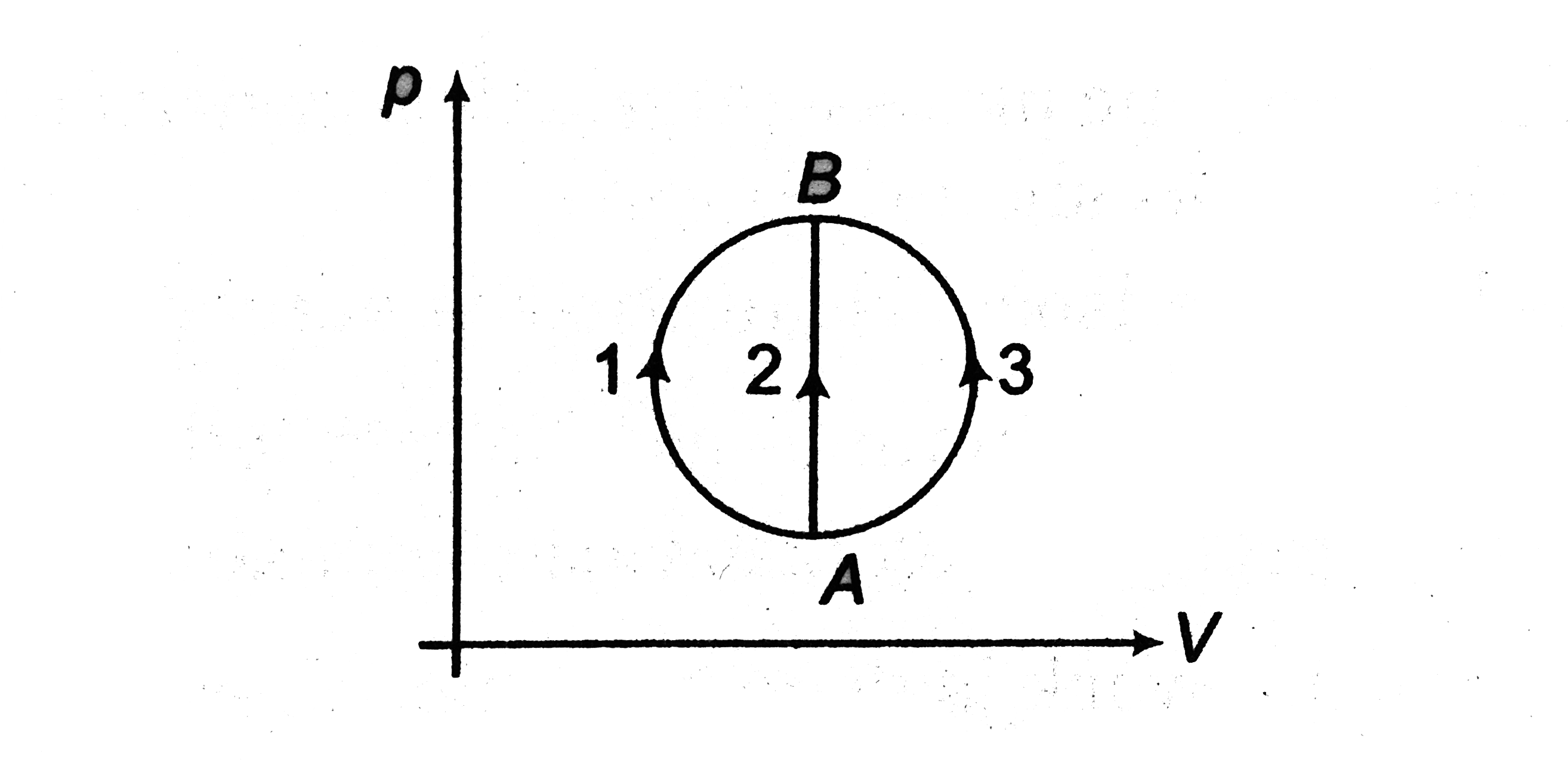An ideal gas is taken through a cyclic thermodynamic process through four steps. The amounts of heat involved in these steps are , , and respectively. The corresponding quantities of work involved are , , and respectively.
(a) Find the value of .
(b) What is the efficiency of the cycle?
The correct Answer is:A, B
To solve the problem step-by-step, we will follow the principles of thermodynamics, specifically applying the first law of thermodynamics to a cyclic process.
Step 1: Understand the First Law of Thermodynamics
The first law of thermodynamics states that:
ΔQ=ΔU+ΔW
For a cyclic process, the change in internal energy (ΔU) is zero, hence:
Qnet=Wnet
Step 2: Calculate the Net Heat Transfer
The net heat transfer (Qnet) for the cycle can be calculated by summing the heat transfers for each step:
Qnet=Q1+Q2+Q3+Q4
Substituting the given values:
Qnet=5960J−5585J−2980J+3645J
Calculating this gives:
Qnet=5960−5585−2980+3645=1040J
Step 3: Calculate the Net Work Done
Similarly, the net work done (Wnet) can be expressed as:
Wnet=W1+W2+W3+W4
Substituting the known values:
Wnet=2200J−825J−1100J+W4
This simplifies to:
Wnet=2200−825−1100+W4=275+W4
Step 4: Set Up the Equation
From the first law, we know:
Qnet=Wnet
Substituting the expressions from Steps 2 and 3:
1040J=275J+W4
Step 5: Solve for W4
Rearranging the equation to find W4:
W4=1040J−275J=765J
Step 6: Calculate the Efficiency of the Cycle
The efficiency (η) of the cycle is given by:
η=WnetQabsorbed×100
Where Qabsorbed is the sum of the heat absorbed during the process:
Qabsorbed=Q1+Q4=5960J+3645J=9605J
Now substituting the values:
η=1040J9605J×100
Calculating this gives:
η≈10.82%
Final Answers:
(a) The value of W4 is 765J.
(b) The efficiency of the cycle is approximately 10.82%.
The first law of thermodynamics states that:
ΔQ=ΔU+ΔW
For a cyclic process, the change in internal energy (ΔU) is zero, hence:
Qnet=Wnet
The net heat transfer (Qnet) for the cycle can be calculated by summing the heat transfers for each step:
Qnet=Q1+Q2+Q3+Q4
Substituting the given values:
Qnet=5960J−5585J−2980J+3645J
Calculating this gives:
Qnet=5960−5585−2980+3645=1040J
Similarly, the net work done (Wnet) can be expressed as:
Wnet=W1+W2+W3+W4
Substituting the known values:
Wnet=2200J−825J−1100J+W4
This simplifies to:
Wnet=2200−825−1100+W4=275+W4
From the first law, we know:
Qnet=Wnet
Substituting the expressions from Steps 2 and 3:
1040J=275J+W4
Rearranging the equation to find W4:
W4=1040J−275J=765J
The efficiency (η) of the cycle is given by:
η=WnetQabsorbed×100
Where Qabsorbed is the sum of the heat absorbed during the process:
Qabsorbed=Q1+Q4=5960J+3645J=9605J
Now substituting the values:
η=1040J9605J×100
Calculating this gives:
η≈10.82%
(a) The value of W4 is 765J.
(b) The efficiency of the cycle is approximately 10.82%.
Topper's Solved these Questions
- BOOK - DC PANDEY ENGLISHCHAPTER - LAWS OF THERMODYNAMICSEXERCISE - Example Type 12videos
LAWS OF THERMODYNAMICS
- BOOK - DC PANDEY ENGLISHCHAPTER - LAWS OF THERMODYNAMICSEXERCISE - Example Type 21videos
LAWS OF THERMODYNAMICS
- BOOK - DC PANDEY ENGLISHCHAPTER - LAWS OF MOTIONEXERCISE - Medical entrances gallery39videos
LAWS OF MOTION
- BOOK - DC PANDEY ENGLISHCHAPTER - MAGNETIC EFFECT OF CURRENT AND MAGNETISMEXERCISE - Integer type Questions10videos
MAGNETIC EFFECT OF CURRENT AND MAGNETISM
Similar Questions
An ideal gas is taken through a cyclic thermodynamic process through four steps. The amounts of heat involved in these steps are Q1=5960J,Q2=−5585J,Q3=−2980JandQ4=3645J, respectively. The corresponding quantities of work involved are W1=2200J,W2=−825J,W3=−1100JandW4 respectively.
(1) Find the value of W4.
(2) What is the efficiency of the cycleView SolutionAn ideal gas is taken through a cyclic thermodynamic process through four steps. The amounts of heat involved in these steps are Q1=5960J,Q2=−5585J,Q3=−2980JandQ4=3645J, respectively. The corresponding quantities of work involved are W1=2200J,W2=−825J,W3=−1100JandW4 respectively.
(1) Find the value of W4.
(2) What is the efficiency of the cycleView SolutionAn ideal gas is taken through a cyclic thermodynamical process through four steps. The amounts of heat involved in these steps areQ1=5960J,Q2=−5585J,Q3=−2980J,Q4=3645J, respectively . The corresponding works involved are W1=2200J,W2=−825J,W3=−1100J,W4 respectively. The value of W4 is
View SolutionAn ideal gas is taken through a cyclic thermodynamics process through four steps. The amount of heat given to the system in these steps are Q1=1000J, Q2=−800J, Q3=450J, Q4=−200J respectively. The efficiency of cycle is nearly
View SolutionA gas is taken through a cyclic process ABCA as shown in, if 2.4 cal of heat is given in the process, what is the value of J ?
 View Solution
View SolutionA gas is taken through a cyclic process ABCA as shown in, if 2.4cal of heat is given in the process, what is the value of J ?
 View Solution
View SolutionA cyclic process contains four steps AB,BC,CD and DA. Heat involved in different processes is given as QAB=+200J,QBC=+600J,QCD=−300J,QDA=0, then efficiency of process is
View SolutionA gas undergoes A to B through three different processes 1,2 and 3 as shown in the figure. The heat supplied to the gas is Q1, Q2 and Q3 respectively, then
 View Solution
View SolutionDuring an isobaric heating process the work done by oxygen gas is 4 J. Calculate the amount of heat transferred to the gas. [γ=1.4]
View SolutionEfficiency of cyclic process is 50% if heat Q1=1915J , Q2=−40J , Q3=125J, then Q4 is unknown then find the value of Q4.
View Solution

